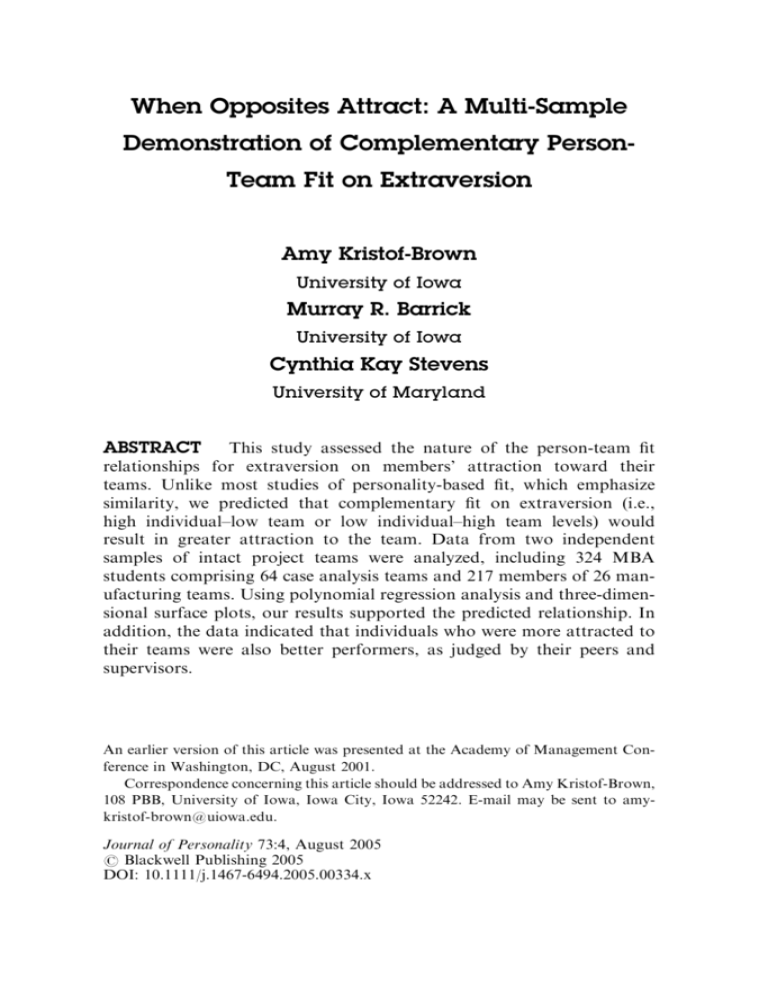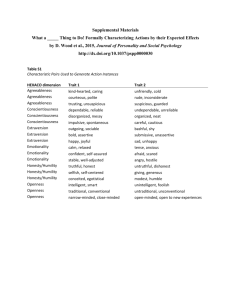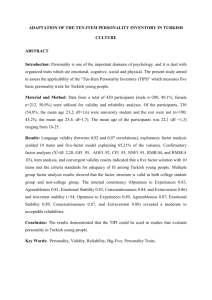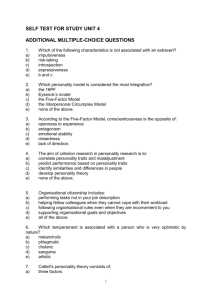When Opposites Attract: A Multi
advertisement

When Opposites Attract: A Multi-Sample Demonstration of Complementary PersonTeam Fit on Extraversion Amy Kristof-Brown University of Iowa Murray R. Barrick University of Iowa Cynthia Kay Stevens University of Maryland ABSTRACT This study assessed the nature of the person-team fit relationships for extraversion on members’ attraction toward their teams. Unlike most studies of personality-based fit, which emphasize similarity, we predicted that complementary fit on extraversion (i.e., high individual–low team or low individual–high team levels) would result in greater attraction to the team. Data from two independent samples of intact project teams were analyzed, including 324 MBA students comprising 64 case analysis teams and 217 members of 26 manufacturing teams. Using polynomial regression analysis and three-dimensional surface plots, our results supported the predicted relationship. In addition, the data indicated that individuals who were more attracted to their teams were also better performers, as judged by their peers and supervisors. An earlier version of this article was presented at the Academy of Management Conference in Washington, DC, August 2001. Correspondence concerning this article should be addressed to Amy Kristof-Brown, 108 PBB, University of Iowa, Iowa City, Iowa 52242. E-mail may be sent to amykristof-brown@uiowa.edu. Journal of Personality 73:4, August 2005 r Blackwell Publishing 2005 DOI: 10.1111/j.1467-6494.2005.00334.x 936 Kristof-Brown, Barrick, Stevens WHEN OPPOSITES ATTRACT: A MULTI-SAMPLE DEMONSTRATION OF COMPLEMENTARY PERSON-TEAM FIT ON EXTRAVERSION Organizations are increasingly turning to teams to accomplish complex assignments such as strategic planning, new product development, and production management (Lawler, Mohrman, & Ledford, 1995). For teams to be effective at these knowledge-intensive tasks, process issues such as the development of shared vocabularies, trust, and strong norms have been identified as important determinants of long-term success (Nahapiet & Ghoshal, 1998). These processes require both time and synergy among team members to develop. Accordingly, teams researchers have begun to move beyond short-term performance determinants toward more sophisticated views of individual and team dynamics as they influence long-term team effectiveness (Marks, Mathieu, & Zaccaro, 2001). One promising approach is to try to gain better understanding of what influences individual team members to contribute to team effectiveness. The relational demography literature offers compelling evidence that an individual’s experience of demographic dissimilarity from other team members influences his or her attitudes and behaviors regarding the team (e.g., Riordan & Shore, 1997; Tsui, Egan & O’Reilly, 1992). Yet, Harrison and colleagues (Harrison, Price & Bell, 1998; Harrison, Price, Gavin & Florey 2002) suggest that while surface-level, demographic differences are important, it is time for research to begin examining the deep-level, psychological features of work teams. One area of research that has been useful in this regard is personenvironment fit (P-E fit). The fundamental premise of fit theories, whether they emphasize vocational choice (e.g., Holland, 1985), adjustment (e.g., French, Caplan, & Harrison, 1974), or individualorganizational value congruence (e.g., Chatman, 1991), is that a good match between the environment and an individual creates compatibilities that result in positive consequences for the individual. Research demonstrates that the personality traits of salient others are defining features of a person’s social environment (e.g., Bretz, Ash, & Dreher, 1989; Schneider, Smith, Taylor, & Fleenor, 1998). Applied to team contexts, P-E fit suggests that an individual member’s personal characteristics, such as personality, will interact with the personal characteristics of teammates to affect his or her responses to the team and task. Complementary Person-Team Fit 937 At the team level, personality traits have been supported as important determinants of team processes and outcomes (Mount, Barrick, & Stewart, 1998). Although numerous personality traits have been studied, results suggest that only a few are consistently related to team-level outcomes. Meta-analytic results suggest that agreeableness, emotional stability, and conscientiousness have positive relationships with team performance (Mount et al., 1998). Barrick, Stewart, Neubert, & Mount (1998) also found that higher average team levels of emotional stability and extraversion were associated with an increased capability of teams to work together. Although these relationships imply a direct relationship of average team personality with team outcomes, Barry and Stewart (1997) found that extraversion demonstrated a unique curvilinear relationship with team outcomes. Specifically, they demonstrated that teams with moderate proportions of extraverts had higher levels of task focus and performance than did all other teams. Similarly, Barrick et al. (1998) found that variability on extraversion was positively associated with supervisor ratings of the team’s long-term capacity to work together. Thus, compared to other personality traits, there appears to be something unique about how team-level outcomes are influenced by team members’ extraversion. This relationship may be better understood by turning to the P-E fit literature to determine how individuals react to the extraversion levels of their team members. Most often fit with the social environment has been operationalized as supplementary fit (Muchinsky & Monahan, 1987), or the similarity between the personalities of individuals and others in their social environment. In general, results suggest that when ‘‘birds of a feather flock together,’’ individuals experience positive outcomes (Chatman, 1991; Ryan & KristofBrown, 2003). Although many studies have supported this type of relationship for other characteristics, such as values or goals (Assouline & Meir, 1987; Burke & Deszca, 1982; Day & Bedian, 1995; Kristof-Brown & Stevens, 2001), this article examines the possibility that another type of fit is at work for extraversion. Complementary fit occurs when the characteristics of an individual complete the environment by offsetting a weakness or filling a gap (Muchinsky & Monahan, 1987). This concept of ‘‘opposites attract’’ is evident in successful dance partners, where one leads and the other follows, and is a fundamental tenet of interpersonal psychology (Gurtman, 2001). For the trait of extraversion, there are compelling reasons to expect 938 Kristof-Brown, Barrick, Stevens that this type of fit, rather than the more commonly predicted supplementary fit, may be advantageous. Thus, the purpose of this article was to evaluate whether complementary person-team fit on extraversion leads individual members to experience increased levels of attraction to, and subsequently higher levels of performance in, teams. Using polynomial regression and three-dimensional response surface plots (Edwards & Parry, 1993), we were able to examine the exact nature of the relationship between individuals’ extraversion levels and those of their team members with attraction to the team. This technique has the added advantage of addressing whether the same relationship holds for extraverts as introverts, as the graphs depict the relationships across all levels of extraversion. Because nonlinear relationships such as fit are often difficult to replicate (Sackett, Gruys, & Ellington, 1998), we tested our hypotheses in two independent samples of intact teams. To the extent that similar results emerge across different team contexts, we can place greater confidence in the findings. Extraversion and Teams As a key trait influencing social interaction, extraversion has been an important focus of interest in the dispositional underpinnings for social behavior (e.g., Barrick & Mount, 1991; Lucas, Diener, Grob, Suh & Shao, 2000). The typical extrovert craves excitement, is adventurous, and tends to be assertive and dominant, as well as sociable. Further, extraversion is a trait for which theory has been developed to explain its operation. For example, extraversion has been linked to brain mechanisms associated with approach (the behavioral activation system; Gray, 1987), reward sensitivity (Lucas et al., 2000), and positive affect (Watson & Clark, 1997). For almost 50 years, scholars have been interested in studying the impact of extraversion in team settings. These studies consistently find some relationship between team composition on extraversion and teamlevel outcomes; often with results suggesting that diversity on extraversion has positive team-level consequences. Hoffman (1959) composed groups as homogeneous or heterogeneous on extraversion and had them generate solutions to two workrelated problems. The heterogeneous groups generated more inventive solutions and reported greater satisfaction with their solutions. A second study (Hoffman & Maier, 1961) that extended this approach to Complementary Person-Team Fit 939 additional problem-solving tasks found that heterogeneous groups also performed better on those tasks and reported greater satisfaction. In a field setting, Barry and Stewart (1997) hypothesized that performance would be highest in MBA teams with a moderate proportion of extroverted members. Their results supported a curvilinear relationship, such that teams with a moderate proportion of extraverts had higher levels of instructor-rated performance than did teams with a smaller or greater proportion of extraverted members. Although this result was not replicated directly in a study by Barrick et al. (1998), they did report that variance on team member extraversion was significantly related to long-term team viability as rated by the team’s supervisor. Taken together, these studies suggest that teams composed of members with varying levels of extraversion may show improved team-level performance, satisfaction, and long-term viability. Yet, it is unclear why this effect exists. The answer may lie in how dissimilarity on extraversion is experienced by individual team members. Viewed from this perspective, the question is, ‘‘Does the extraversion of one team member influence the behavior of other team members?’’ Addressing this question necessitates taking a fit perspective, rather than concentrating on team-level composition. A person-team fit approach requires considering an individual’s level of extraversion in the context of the level of extraversion demonstrated by other team members. The notion of complementary fit may explain how being different from other team members on extraversion would lead an individual member to react positively toward the team. Most studies of personality-based fit emphasize the benefits that accrue from supplementary fit, or personality similarity, between individuals and others in their social environment. However, complementary fit, which exists when the characteristics of individuals and their environments offset each other, may be more relevant to the specific trait of extraversion. Careful consideration of the extraversion trait illustrates why complementarity, rather than similarity, would fulfill team members’ needs and thus increase their affect toward the team. There is extensive evidence that complementarity in dominance (a component of extraversion) and submissiveness is related to higher quality interpersonal interactions. Leary’s interpersonal circle (1957) depicts between-person variations on a single circular array containing two axes, dominance-submissiveness and love-hate. While similarity on the love-hate dimension is desirable, dissimilarity is preferable on the dominance-submissiveness axis 940 Kristof-Brown, Barrick, Stevens because it establishes a reciprocal relationship in which both sides have their needs met (Carson, 1969). Extrapolating these findings to the broader trait of extraversion, the interpersonal behaviors demonstrated by an extravert invite a particular response from those around them (e.g., ‘‘I would like to speak. You listen.’’). The introvert listens, which then invites the extravert to continue speaking, thus establishing an ongoing relationship. This type of mutually fulfilling interaction is desirable to both sides, thereby increasing attraction. In the work domain, there is also evidence of increased performance in dyads and teams where there is some level of complementarity. For example, Smelser (1961) investigated dyads that varied on dominant–submissive traits and found that in cooperative problemsolving settings, the most productive dyads were those with complementary traits (a person scoring high in dominance working with a person low in dominance). Similarly, Ghiselli and Lodahl (1958) found that groups performed better on a cooperative task when the group included one relatively dominant member and two or three average- or low-dominance members. Finally, as noted earlier, Hoffman (Hoffman, 1959; Hoffman & Maier, 1961) found that individuals in groups heterogeneous on extraversion were not only more productive (generated more solutions) but also were more satisfied than members of groups that were similar on extraversion. In each of these cases, it is presumed that the matching of dissimilar others helped meet an individual’s need for dominance or extraversion, resulting in better working relationships and subsequent performance. Mullen and Copper (1994) conclude in their meta-analysis that teams experiencing high levels of performance become more cohesive, meaning that their members are more attracted to the team than if the team had poor performance. Therefore, if a complementary fit can help improve team performance, individual members’ attraction to the team should also increase. These results reveal that people have an easier time working together when one asserts and others acquiesce. Easier working conditions, coupled with the successful performance that should result from such a partnership, are likely to increase individuals’ attraction to the team. Thus, we posit the following relationship: Hypothesis 1: Individuals will experience greater attraction toward their teams when their levels of extraversion are dissimilar, rather than similar, to that of team members. Complementary Person-Team Fit 941 Member Attraction and Performance Although an individual’s attraction to a team may influence the group’s long-term viability, a more direct consequence is the individual’s behavior in the team setting. Members who are more attracted to their teams should be more likely to perform in ways that benefit the team. Although the relationship between team-level cohesion and team performance depends on whether the team holds high performance norms (Gully, Devine, & Whitney, 1995; Mullen and Cooper, 1994), at the individual level, a member who is attracted to the team should consistently perform in ways that other team members value. These individuals should strive to support their teams in accomplishing their objectives because they value the success of the team and their continued membership in it. Schriesheim (1980) shows attraction to a team’s leader significantly influenced the individual’s performance in the team (r 5 .24). Performance may take the form of direct contributions to completing task-related activities, or indirect contributions through sustaining and supporting the team (Bales, 1948). This relationship should hold, even if the team endorses low performance norms. For example, if a person is attracted to a team with low performance norms, that person is still likely to act in ways that other members see as valuable (e,g., telling jokes, socializing, doing the appropriate amount of work to reach the agreed-upon performance goal). Thus, that person’s contributions would be rated as high by others on his or her team, even though they may not result in higher team performance. Thus, we predict a positive relationship between attraction and an individual’s contributions, as rated by other members of the team. Hypothesis 2: Individuals with higher attraction toward their teams will be rated by others as making greater contributions than will those who are less attracted to their teams. METHOD Data for this study was based on existing data collected as part of two larger studies designed to collect multiwave data on functioning teams. Although some of this data has been used to address other distinct re- 942 Kristof-Brown, Barrick, Stevens search questions, there is no duplication in the causal relationships reported in the previously published research and in this study. The hypotheses were tested first on the sample of MBA project teams, described in detail in Kristof-Brown and Stevens (2001). Data collection for that project involved assessing a wide range of individual characteristics, including goals (the focus of Kristof-Brown & Stevens, 2001) and personality traits (the focus of this study). Because nonlinear relationships, such as those predicted in this study, are often difficult to replicate, we wanted to verify that a distinct sample would provide similar results. Barrick et al. (1998) had collected comparable, individual-level data from a sample of manufacturing teams. Although the measures differ slightly, verifying that similar results exist in both samples provides stronger evidence for the relationships reported. Despite their different settings (a university class vs. a manufacturing organization), both samples meet the criteria outlined by Guzzo & Dickson (1996) for being considered a team. Specifically, they: (a) viewed themselves and were viewed by others as part of a social entity (either a self-selected team with an identifiable name or an existing work unit that reported to a single supervisor), (b) completed interdependent work (either course assignments or assembly/maintenance of a line of small appliances), (c) were embedded in a larger social system (either a management class or an organization), and (d) performed tasks that affect others (either assignments turned in to a professor or small appliances sold to customers). Study 1 Sample and procedure. Participants included 324 full-time and part-time MBA students (65.1% male) enrolled in eight sections of a core course. As part of their regular class activities, all students self-selected into 4- to 7-member project teams that generated a written and oral case analysis report worth 50% of the final course grade. Average team size was 5.39 (SD 5 .81). These teams (n 5 64) represented 86% of the total student enrollment. Their mean age was 26.35 years (SD 5 3.52), and they averaged 3.65 years of full-time work experience (SD 5 3.03) in 1.66 (SD 5 1.26) organizations. Study participants were 59% Caucasian, 17% Asian/Pacific Islander, and 24% other ethnicities. The team task necessitated intensive work by all project team members, including turning in a preliminary outline, meeting as a team with the instructor to receive feedback, preparing a 15-page final report, and making a final oral presentation. Participation in the study involved providing measures of: (a) personality, self-rated at the beginning of the course; (b) attraction to the team, self-rated after several weeks of work- Complementary Person-Team Fit 943 ing with the team; and (c) team-member contributions, rated by peers at the conclusion of the course after the projects were completed. Measures. Prior to beginning work on the team case analysis, participants completed Goldberg’s (1992) measure of extraversion. This measure consists of seven sets of bipolar adjectives on which participants were asked to rate themselves as compared to other people of their same age. The rating scale ranged from (1) very (Trait A) to (4) neither (Trait A or Trait B) to (7) very (Trait B). Trait A and Trait B anchors for the scale included: introverted–extroverted, unenergetic–energetic, silent–talkative, timid–bold, inactive–active, unassertive–assertive, unadventurous–adventurous. Responses to these items were averaged to yield an extraversion scale score, which demonstrated acceptable reliability (a 5 .84). We calculated the average level of team extraversion for each respondent by averaging all team members’ scores, minus the focal respondent. To evaluate individuals’ attraction toward the team we used Seers’s (1989) eight-item cohesiveness scale because cohesiveness, when measured at the individual level, has been defined as the degree to which members are attracted to the team (Gully et al., 1995; Keyton & Springston, 1990). After several weeks of working together, but prior to receiving a final team grade, participants rated the extent to which they agreed with statements regarding their attraction toward the team (e.g., ‘‘I’d rather not be on this team [reverse]). All items were scored on a 7-point scale anchored by (1) strongly disagree through (4) neutral to (7) strongly agree. The scale demonstrated acceptable reliability (a 5 .90). Individual performance in the team context was evaluated by peers at the conclusion of the course using Kristof-Brown and Stevens’s (2001) measure of interpersonal (four items, i.e., ‘‘maintained positive outlook/ sense of humor in stressful situations,’’ a 5 .82) and task-related (seven items, i.e., ‘‘contributed original ideas to case solution,’’ a 5 .91) contributions. Each individual was rated by every other member of the team on how often he or she engaged in behaviors that contributed to the team’s success: (1) never, (4) sometimes, (7) always. The average of all team members’ ratings was used to determine an interpersonal and task-related performance score for each participant (average ICC2 5 .60). Study 2 Sample and procedure. Participants consisted of 217 members of 26 assembly and maintenance teams employed in two manufacturing firms. All had the responsibility of working with their team to complete their major work assignments. Average team size was 10.68 members (SD 5 4.21). Participants had an average tenure in their organization of 17.22 years 944 Kristof-Brown, Barrick, Stevens (SD 5 6.17), and average tenure on their teams of 3.12 years (SD 5 3.09). As part of a larger study of team effectiveness, participants completed the Personal Characteristics Inventory (PCI; Barrick & Mount, 1995) and reported their individual perceptions of social attachment. Participants completed all measures (demographic information, personality questionnaire, and perceptions of attraction) during a workshop on teams. The assessment period was part of a week-long workshop on work teams, involving all employees of the plants. Measures. Participants completed the PCI’s extraversion scale, which consists of 30 items (i.e., ‘‘I like initiating conversations with people I do not know,’’ ‘‘I tend to be more of a follower than a leader’’ reversescored) averaged to yield a scale score. They rated each item on a 3-point, Likert-type scale (from 1 5 disagree to 3 5 agree). The scale’s internal consistency was acceptable (a 5 .86). As with the MBA sample, we calculated the average level of team extraversion by averaging the scores of all individual members of the team, excluding the focal member. Attraction toward the team was measured using Stokes’s (1983) sevenitem scale of social cohesiveness. Participants used a 5-point Likert scale (1 5 strongly disagree; 5 5 strongly agree) to rate the extent to which they agreed with statements regarding the team (e.g., ‘‘I get along well with other members of this team.’’). The internal consistency of the scale was acceptable (a 5 .89). Individual performance was assessed using supervisor’s ratings of each team member. An eight-item measure of individual performance was developed, based on a job analysis. Sample items include ‘‘Maintains good working relationships with others,’’ ‘‘Demonstrates a consistent, dependable work effort and a positive work attitude.’’ Each individual was rated on a 5-point scale (1 5 somewhat below expectations; 5 5 consistently exceeds requirements). Coefficient alpha for this scale was .85. Analyses A complementary fit relationship could best be evaluated by examining the exact relationship between individual and team extraversion and attraction. Polynomial regression (Edwards, 1993, 1994), which uses unconstrained regression equations to generate corresponding three-dimensional surface graphs of the relationship, permits the requisite degree of precision (Edwards & Parry, 1993). The equation for the predicted fit relationship includes separate measures of person and team extraversion, the squared terms for each, and their interaction (see Edwards 1993, 1994). The expression for the equation is: A ¼ b0 þ b1 P þ b2 T þ b3 P2 þ b4 PT þ b5 T2 Complementary Person-Team Fit 945 in which P represents an individual’s level of extraversion, T is the average level of extraversion of the remaining team members, and A is the individual’s attraction toward the team. To reduce multicollinearity and facilitate interpreting the graphs, all extraversion measures were first scale-centered (Edwards, 1994), by subtracting the scale midpoint (4 on Goldberg’s 7-point scale, 2 on the PCI’s 3-point scale). This makes the range of P and T extraversion values -3 to 3 in the MBA sample, and -1 to 1 in the manufacturing sample. Polynomial regression has the advantage of allowing us to examine the relationship with attraction across all levels of extraversion. Furthermore, control variables such as team size and variance on extraversion can be included in the regression. This is important because it isolates the impact of individuals’ unique fit relationships, independent of team characteristics that have been shown to influence attraction at the team level. Therefore, if the DR2 for this set of extraversion-related predictors is statistically significant, it suggests that some type of relationship between individual and team members’ extraversion levels influences attraction. However, the nature of that relationship can only be determined by examining plots of the three-dimensional surfaces generated from the unstandardized regression coefficients (b1, b2, b3, b4, b5 from above). A simple inspection of the graph can provide useful information of attraction levels under all conditions of person-team similarity and dissimilarity. One implication is that we can determine whether the same relationship holds for extraverts and introverts. If a similar complementary fit relationship exists, higher levels of attraction will occur whenever individual and average team extraversion levels are maximally different, i.e., when an introvert (-3) is in a team of extraverts (3), or an extravert (3) is in a team of introverts (-3). In the graph, this will appear as a u-shaped surface running from the far left corner (i.e., 3, -3 in Figure 1) to the far right (-3, 3 in Figure 1) corner of the graph. RESULTS To better identify the effects of person-team fit, we controlled for two theoretically interesting variables. First, because team size has been found to negatively relate to cohesion at the team level (Mullen & Cooper, 1994), we controlled for its influence on members’ attraction toward their teams. In addition, we controlled for variability of team members’ levels of extraversion. This was included because Barry and Stewart’s (1997) results suggest that people in general (regardless of their level of extraversion) prefer to be in groups that are balanced with respect to the representation of extraverts. Thus, 946 MBA Teams 3 1.8 1.8 0.6 − 0.6 − 0.6 0.6 − 1.8 − 1.8 n − 3 Team −3 Perso 13 12 11 10 9 8 7 6 5 4 3 2 1 0 Attraction Kristof-Brown, Barrick, Stevens 3 Figure 1 Surface plots of unstandardized regression weights for individual and average team extraversion with attraction to the team in the MBA teams sample. controlling for the variance on this trait allows stronger conclusions regarding the impact of person-team fit to be drawn. The variance score for each respondent was calculated using the same procedure as for the team average, by taking the variance of all team members’ scores, minus the score of the focal respondent. Descriptive statistics and correlations for all measures for the MBA sample are reported in Table 1 and for the manufacturing sample in Table 2. In both samples there is a statistically significant positive correlation between individual extraversion and attraction toward team. In the manufacturing sample, the correlation between average team extraversion and attraction was also statistically significant. As expected, in both samples, attraction toward the team was positively correlated to team variance on extraversion and negatively related to team size. To test Hypothesis 1, we regressed individuals’ attraction to their teams on the two control variables, followed by the five fit-related terms (individual extraversion (P), team extraversion (T), individual extraversion squared (P2), individual team extraversion (PT), team extraversion squared (T2), in each sample. Table 3 reports that the 2 3 4 5 6 7 .34n .01 .07 (.84)c .02 .18n .00 .10 .09 .23n .10 (.90) .02 .03 .02 .14n .23n (.82) .04 .01 .00 .06 .14n .64n (.91) 1 N 5 324; baverage team member extraversion is the team average minus the focal member; values on the diagonal are a reliabilities for the scales. c a .81 .04 .78 .39 .98 .46 .48 5.39 .04 5.07 5.07 5.46 6.50 6.51 1. 2. 3. 4. 5. 6. 7. Team size Extraversion variance Individual extraversion (Goldberg, 1992) Average team extraversionb Attraction to the team (Seers, 1989) Interpersonal contributions (Kristof-Brown & Stevens, 2001) Task contributions (Kristof-Brown & Stevens, 2001) Mean SD Samplea Table 1 Means, Standard Deviations, Reliabilities, and Correlations of Study Variables for the MBA Teams Sample b 4.21 .08 .39 .21 .77 .84 SD .13 .21 .41n .22n .25n 1 c N 5 217; average team member extraversion is the team average minus the focal member; values on the diagonal are a reliabilities for the scales. a 10.68 .14 1.93 1.93 3.57 3.53 1. 2. 3. 4. 5. 6. Team size Extraversion variance Individual extraversion (Barrick & Mount, 1995) Average team extraversionb Attraction to the team (Stokes, 1983) Individual performance (new measure) Mean Samplea .07 .08 .14n .19n 2 (.86)c .18n .20n .17n 3 .16n .09 4 (.87) .49n 5 (.85) 6 Table 2 Means, Standard Deviations, Reliabilities, and Correlations of Study Variables for the Manufacturing Teams Sample 949 Complementary Person-Team Fit Table 3 Results From Polynomial Regressions of Attraction to the Team on Individual and Team Extraversion MBA teamsa Controls: Size Team variance on extraversion P (b1) T (b2 P2 (b3) PT (b4) T2 (b5) c R2 d DR2 Manufacturing teamsb .10 1.74 .43 .29 .09 .31 .15 .09n .08n Controls: Size Team variance on extraversion P (b1) T (b2) P2 (b3) PT (b4) T2(b5) R2 DR2 .03n .90 .19 .32 .11 1.78n .08 .12n .06n a N 5 317 for MBA sample; bN 5 217 for manufacturing sample; po.05 R2 is the overall explained variance for the model including all predictors. d DR2 indicates the increase in explained variance in the polynomial analysis due to the addition of the fit terms. c amount of variance explained by the set of fit terms, beyond the control variables, was statistically significant for both samples (MBA sample DR2 5 .08, po.05; manufacturing sample DR2 5 .05, po.05. Although these results suggest that some relationship exists between individual extraversion, average team extraversion, and attraction, they do not specify the form of relationship. To determine whether complementary fit existed, we examined the surface plots. The resulting graphs, shown in Figures 1 and 2, for the MBA and Manufacturing samples, respectively, showed the predicted u-shaped relationship. Both graphs begin at a high point in the far left corner, decline toward the middle of the graph, and then rise again on the far right corner. This indicates that attraction to the team was highest when the individual was high on extraversion and the team was low and when the individual was low and the team was high. Thus, Hypothesis 1, which predicted a complementary fit relationship for extraversion and attraction to the team, was supported in both samples. Simply stated, extraverts are more attracted to teams where others are introverted, and introverts are more attracted to teams of extraverts. Hypothesis 2 stated that individual members’ attraction to their teams would be positively related to their performance in the team 950 Kristof-Brown, Barrick, Stevens Manufacturing Teams 8 7 5 4 Attraction 6 3 2 1 0 1 0. 6 0.2 − 0.2 Team − 0.6 − 1 − 1 − 0.6 0.2 − 0.2 on r Pe s 0.6 1 Figure 2 Surface plots of unstandardized regression weights for individual and average team extraversion with attraction to the team in the manufacturing teams sample. context. For the MBA sample, we tested this hypothesis by examining the bivariate correlations of the individual performance measures with individuals’ attraction to the team. As predicted, there was a statistically significant relationship between individuals’ attraction to the team and peer ratings of their interpersonal (r 5 .23, po.05) and task (r 5 .14, po.05) performance. In the manufacturing teams sample, the bivariate correlation between individuals’ attraction to the team and supervisor’s ratings of their individual performance was also positive (r 5 .48, po.05), supporting Hypothesis 2 in the field sample. Therefore, in both samples, there is evidence that individual team members who are more attracted to their teams are viewed by others as contributing more to the team than those who are less attracted to their teams. DISCUSSION This study explored whether complementary person-team fit on extraversion influences individual members’ attraction to their teams Complementary Person-Team Fit 951 and subsequent performance. In two independent samples, we found that members reported greater attraction to their teams when their level of extraversion was dissimilar to the average level of extraversion of other team members. These results suggest a complementary fit relationship between extraversion and attraction that holds for extraverts as well as introverts. This finding is significant as it is generally assumed that similarity on psychological characteristics will result in more positive consequences, and complementary fit is relevant only for knowledge or skills (Klimoski & Jones, 1995). Our results directly contradict this assumption. In addition, we found that when individual team members are more attracted to their teams, they make greater individual contributions to that team’s success. Taken together, these results underscore the need to understand more fully how personality traits of individual team members influence their experiences in teams. Our results contribute to the existing literatures on both P-E fit and personality in teams. Although several authors have advocated the importance of fit within teams (e.g., Judge & Ferris, 1992; Werbel & Gilliland, 1999), few empirical studies have investigated this topic. Instead, research has emphasized the fit between supervisors and subordinates (Vancouver & Schmitt, 1991; Witt, 1998), employees and their cohorts (Vancouver & Schmitt, 1991), or employees and all existing members of their organizations (Ferris, Youngblood, & Yates, 1985). In addition, this study used a precise analytical technique to empirically demonstrate a complementary fit relationship across two independent samples. To our knowledge, such a relationship on a personality trait has never been reported or verified in independent samples. Furthermore, this study contributes to the personality in teams literature by being the first to show that individual members’ attitudes toward their teams are influenced by person-team fit, even after controlling for team-level composition. As such, they rule out the alternative explanation that team-level variability can best explain individual-level outcomes in team settings. As interest in personality predictors of work-related outcomes has increased, our results demonstrate the utility of examining personality in context. Studies that show that organizations develop modal personalities over time, supporting Schneider’s (1987) attractionselection-attrition model, may be used as models for examining whether such processes also occur at the team level. If they do, the implication is that teams will seek to add similar others, rather than 952 Kristof-Brown, Barrick, Stevens seeking diversity on traits like extraversion. Thus, just as Schneider, Goldstein, and Smith (1995) warned of the ‘‘dark side of good fit’’ for organizations (i.e., the desire for supplementary fit resulting in excessive homogeneity), there are negative consequences of allowing such processes to occur within work teams. Taken together, our results and those by Barry and Stewart (1997) reveal that extraversion is especially important in work settings requiring a high degree of social interaction, such as work teams. At the individual level, our findings show that extraversion affects group functioning through its impact on socioemotional interactions that take place among group members, and each member’s standing on this trait influences the effectiveness of those interactions. Specifically, dissimilarity in members’ level of extraversion stimulated feelings of attraction toward the team. This contradicts the notion that homogeneity in groups is the primary means by which one enhances cohesion and communication (Byrne, 1971; Turner, 1987). As meta-analyses have demonstrated the positive effect between individuals’ attraction to a team and their performance in the team setting (Gully et al., 1995; Mullen & Copper, 1994), our results also offer insight into how personality complementarity may induce individuals to contribute more fully to team-based work. Future research should focus on better understanding why complementarity is preferable on extraversion. We have argued that the process is one of need fulfillment, in which extraverts and introverts have their needs met through interpersonal interactions with each other. This proposition could be directly tested by assessing needs and need satisfaction in homogeneous and heterogenous teams. Furthermore, recent research has linked extraversion with broader constructs such as approach-motivation (Elliot & Thrash, 2002) and positive emotionality/temperament (Watson & Clark, 1997). It is unclear whether complementarity on these broader characteristics would be desirable or whether the more common finding of supplementary fit would prevail. Research conducted on these characteristics from a person-environment fit perspective would be informative. One limitation of this study is that individuals’ reports of extraversion and feelings of attraction were both collected using selfreports. This raises the possibility that correlated errors and common method bias may have increased the correlation between these two variables. However, because the relationships we demonstrated were Complementary Person-Team Fit 953 complex, involving the additional component of team extraversion (measured as the average of others’ self-reports), it is unlikely that such bias could explain the pattern of our results. Moreover, the likely impact of common method bias would have been to strengthen the main effect for individual extraversion, making it less likely to demonstrate the more complicated complementary fit relationship. Moreover, this study has several strengths that bolster confidence in our conclusions. The use of two independent samples from diverse team settings provided a stringent test of our hypotheses. Although both samples contained work teams experiencing genuine performance incentives, the type of work they performed was very different. The MBA teams included demographically diverse members who worked on a problem-solving task for several weeks. Alternatively, the manufacturing teams were demographically similar and engaged in behavioral tasks (McGrath, 1984) that involved high planning and performance demands over a period of several years. Replicating the complementary fit relationship across these diverse samples, time frames, and tasks suggests the robustness of this phenomenon. Disadvantages of this approach, however, are that different measures were used in both studies and a limited number of meaningful control variables existed across both contexts. Additional variables such as leader behaviors and average team tenure might also influence attraction in at least one of the contexts. A second strength is that we used measures of actual average team extraversion, rather than individuals’ perceptions of their team’s extraversion. This is beneficial because it suggests that managers can use information obtained from personality tests to construct teams that will result in more positive experiences for their members. Our findings have important implications for selection as they suggest that one should not only consider the attributes of the candidate being considered for hire but also those of the other team members. They provide empirical support for the notion recently advocated by others that fit should be taken into consideration during hiring and placement activities in addition to person-job fit, which has traditionally been the emphasis of selection decisions (Werbel & Gilliland, 1999). Our results also provide support for the usefulness of personality tests as selection devices. As work becomes more frequently organized using work teams, it is apparent that noncognitive predictors, particularly those assessing social skills, will be increasingly important to include in a selection battery. 954 Kristof-Brown, Barrick, Stevens In conclusion, the present study provides substantial support for the complementary nature of extraversion in work teams. When work teams have too many dominant team members (or too few), individuals encounter more difficulties in getting along with each other, which, in turn, may lead to worse individual performance. Rather than birds of a feather flocking together, with regard to extraversion in work teams, opposites attract. REFERENCES Assouline, M., & Meir, E. I. (1987). Meta-analysis of the relationship between congruence and well-being measures. Journal of Vocational Behavior, 31, 319– 332. Bales, R. F. (1948). Interaction process analysis: A method for the study of small groups. Cambridge, MA: Addison-Wesley. Barrick, M. R., & Mount, M. K. (1991). The Big Five personality dimensions and job performance: A meta-analysis. Personnel Psychology, 44, 1–26. Barrick, M. R., & Mount, M. K. (1995). The Personal Characteristics Inventory manual. Unpublished manuscript, The University of Iowa, Iowa City. Barrick, M. R., Stewart, G. L., Neubert, M. J., & Mount, M. K. (1998). Relating member ability and personality to work-team processes and team effectiveness. Journal of Applied Psychology, 83, 377–391. Barry, B., & Stewart, G. L. (1997). Composition, process, and performance and in self-managed groups: The role of personality. Journal of Applied Psychology, 82, 62–78. Bretz, R. D., Ash, R. A., & Dreher, G. F. (1989). Do people make the place? An examination of the attachment-selection-attrition hypothesis. Personnel Psychology, 42, 561–581. Burke, R. J., & Deszca, E. (1982). Preferred organizational climates of Type A individuals. Journal of Vocational Behavior, 21, 50–59. Byrne, D. (1971). The attachment paradigm. New York: Academic Press. Carson, R. C. (1969). Interaction concepts of personality. Chicago: Aldine. Chatman, J. (1991). Matching people and organizations: Selection and socialization in public accounting firms. Administrative Science Quarterly, 36, 459–484. Day, D. V., & Bedeian, A. G. (1995). Personality similarity and work-related outcomes among African-American nursing personnel: A test of the supplementary model of P-E congruence. Journal of Vocational Behavior, 46, 55–70. Digman, J. M. (1997). Higher-order factors of the big five. Journal of Personality and Social Psychology, 73, 1246–1256. Edwards, J. R. (1993). Problems with the use of profile similarity indices in the study of congruence in organizational research. Personnel Psychology, 46, 641–665. Edwards, J. R. (1994). The study of congruence in organizational behavior research: Critique and a proposed alternative. Organizational Behavior and Human Decision Processes, 58, 51–100. Complementary Person-Team Fit 955 Edwards, J. R., & Parry, M. E. (1993). On the use of polynomial regression equations as an alternative to difference scores in organizational research. Academy of Management Journal, 36, 1577–1613. Elliot, A. J., & Thrash, T. M. (2002). Approach-avoidance motivation in personality: Approach and avoidance temperaments and goals. Journal of Personality and Social Psychology, 82, 804–818. Elphick, E., Halverson, C. F. Jr., & Marszal-Wisniewska, M. (1998). Extraversion: Toward a unifying description from infancy to adulthood. In G. A. Kohnstamm & C. F. Halverson Jr., et al. (Eds). Parental descriptions of child personality: Developmental antecedents of the Big Five? (pp. 21–48). Mahwah, NJ: Lawrence Erlbaum. Ferris, G. R., Youngblood, S. A., & Yates, V. L. (1985). Personality, training performance, and withdrawal: A test of the person-group fit hypothesis for organizational newcomers. Journal of Vocational Behavior, 27, 377–388. French, J. R. P. Jr., Caplan, R. D., & Harrison, R. V. (1982). The mechanisms of job stress and strain. London: Wiley. Ghiselli, E.E, & Lodahl, T. M. (1958). The evaluation of foremen’s performance in relation to the internal characteristics of their work groups. Personnel Psychology, 11, 179–187. Goldberg, L. R. (1992). The development of markers for the big-five factor structure. Psychological Assessment, 4, 26–42. Gray, J. A. (1987). Perspectives on anxiety and impulsivity: A commentary. Journal of Research in Personality, 21, 493–509. Gully, S. M., Devine, D. J., & Whitney, D. J. (1995). A meta-analysis of cohesion and performance: Effects of level of analysis and task interdependence. Small Group Research, 26, 497–520. Gurtman, M. B. (2001). Interpersonal complementarity: Integrating interpersonal measurement with interpersonal models. Journal of Counseling Psychology, 48, 97–110. Guzzo, R. A., & Dickson, M. W. (1996). Teams in organizations: Recent research on performance and effectiveness. Annual Review of Psychology, 47, 307–338. Harrison, D.A, Price, K. H., Gavin, J. H., & Florey, A. T. (2002). Time, teams, and task performance: Changing effects of surface- and deep-level diversity on group functioning. Academy of Management Journal, 45, 1029–1045. Harrison, D.A, Price, K. H., & Bell, M. P. (1998). Beyond relational demography: Time and the effects of surface- and deep-level diversity on work group cohesion. Academy of Management Journal, 41, 96–107. Hoffman, L. R. (1959). Homogeneity of member personality and its effect on group problem-solving. Journal of Abnormal and Social Psychology, 58, 27–32. Hoffman, L.R, & Maier, N. R. F. (1961). Quality and acceptance of problem solutions by members of homogeneous and heterogeneous groups. Journal of Abnormal and Social Psychology, 62, 401–407. Holland, J. L. (1985). Making vocational choices: A theory of careers (2nd ed.). Englewood Cliffs, NJ: Prentice-Hall. Judge, T. A., & Ferris, G. R. (1992). The elusive criterion of fit in human resource staffing decisions. Human Resource Planning, 15 (4), 47–67. 956 Kristof-Brown, Barrick, Stevens Keyton, J., & Springston, J. (1990). Redefining cohesiveness in groups. Small Group Research, 21, 234–254. Klimoski, R., & Jones, R. G. (1995). Staffing for effective group decision making: Key issues in matching people and teams. In R. A. Guzzo & E. Salas Associates (Eds.), Team effectiveness and decision making in organizations (pp. 291– 332). San Francisco: Jossey-Bass. Kristof-Brown, A. L., & Stevens, C. K. (2001). Goal congruence in project teams: Does the fit between members’ personal mastery and performance goals matter? Journal of Applied Psychology, 86, 1083–1095. Lawler, E. E. III, Mohrman, S. A., & Ledford, G. E. Jr. 1995. Creating high performance organizations: Practices and results of employee involvement and total quality management in Fortune 1000 companies. San Francisco: Jossey-Bass. Leary, T. (1957). Interpersonal diagnosis of personality. New York: Ronald Press. Lucas, R. E., Diener, E., Grob, A., Suh, E. M., & Shao, L. (2000). Cross-cultural evidence for the fundamental features of extraversion. Journal of Personality & Social Psychology, 79, 452–468. Marks, M. A., Mathieu, J. E., & Zaccaro, S. J. (2001). A temporally-based theory and taxonomy of team processes. Academy of Management Review, 26, 356–376. McGrath, J. E. (1984). Groups: Interaction and performance. Englewood Cliffs, NJ: Prentice-Hall. Mount, M. K., Barrick, M. R., & Stewart, G. L. (1998). Five-factor model of personality and performance in jobs involving interpersonal interactions. Human Performance, 11, 145–165. Muchinsky, P. M., & Monahan, C. J. (1987). What is person-environment congruence? Supplementary versus complementary models of fit. Journal of Vocational Behavior, 31, 268–277. Mullen, B., & Cooper, C. (1994). The relation between group cohesiveness and performance: An integration. Psychological Bulletin, 115, 210–217. Nahapiet, J., & Ghoshal, S. (1998). Social capital, intellectual capital, and the organizational advantage. Academy of Management Review, 23, 242–266. Riordan, C. M., & Shore, L. M. (1997). Demographic diversity and employee attitudes: An empirical examination of relational demography within work units. Journal of Applied Psychology, 82, 342–358. Ryan, A. M., & Kristof-Brown, A. L. (2003). Personality’s role in person-organization fit: Unresolved issues. Barrick, M. & Ryan, A. M. (Eds.), Personality and work (pp. 262–288). San Francisco: Jossey-Bass. Sackett, P. R., Gruys, M. L., & Ellington, J. E. (1998). Ability-personality interactions when predicting job performance. Journal of Applied Psychology, 83, 545–556. Schneider, B. (1987). The people make the place. Personnel Psychology, 40, 437–453. Schneider, B., Goldstein, H. W., & Smith, D. B. (1995). The ASA framework: An update. Personnel Psychology, 48, 747–773. Schneider, B., Smith, D. B., Taylor, S., & Fleenor, J. (1998). Personality and organizations: A test of the homogeneity of personality hypothesis. Journal of Applied Psychology, 83, 462–470. Complementary Person-Team Fit 957 Schriesheim, J. (1980). The social context of leader-subordinate relations: An investigation of the effects of group cohesiveness. Journal of Applied Psychology, 65, 183–194. Seers, A. (1989). Team-member exchange quality: A new construct for rolemaking research. Organizational Behavior and Human Decision Processes, 43, 118–135. Smelser, W. T. (1961). Dominance as a factor in achievement and perception in cooperative problem solving interactions. Journal of Abnormal & Social Psychology, 62, 535–542. Stokes, J. P. (1983). Components of group cohesion: Intermember attraction, instrumental value, and risk taking. Small Group Behavior, 14, 163–173. Tsui, A. S., Egan, T. D., & O’Reilly, C. A. (1992). Being different: Relational demography and organizational attachment. Administrative Science Quarterly, 37, 547–579. Turner, J. C. (1987). Rediscovering the social group: A self-categorization theory. Oxford: Basil Blackwell. Vancouver, J. B., & Schmitt, N. W. (1991). An exploratory examination of person–organization fit: Organizational goal congruence. Personnel Psychology, 44, 333–352. Watson, D., & Clark, L. A. (1997). Extraversion and its positive emotional core. In R. Hogan & J. A. Johnson, et al. (Eds.). Handbook of personality psychology (pp. 767–793). San Diego, CA: Academic Press. Werbel, J. D., & Gilliland, S. W. (1999). Person-environment fit in the selection process. In G. R. Ferris (Ed.). Research in personnel in human resource management: Vol. 17 (pp. 209–243). Stamford, CT: JAI Press. Wiggins, J.S, & Trapnell, P. D. (1997). Personality structure: The return of the big five. In R. Hogan & J. A. Johnson, et al. (Eds.) Handbook of personality psychology (pp. 737–765). San Diego, CA: Academic Press. Witt, L. A. (1998). Enhancing goal congruence: A solution to organizational politics. Journal of Applied Psychology, 83, 666–674. 958







